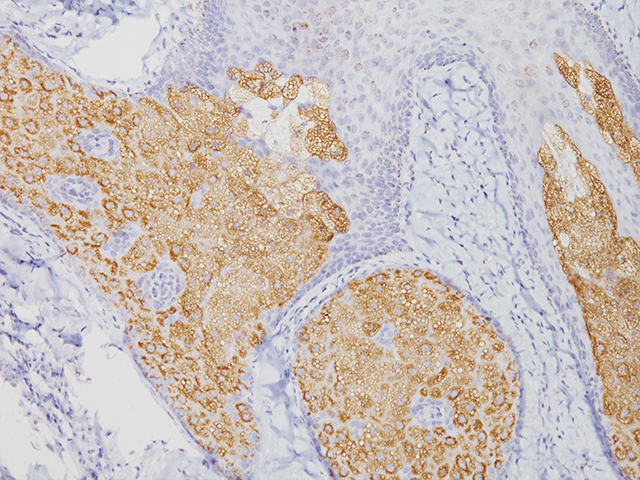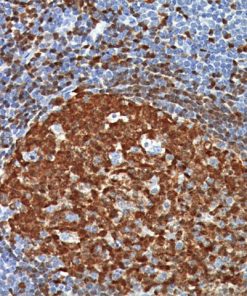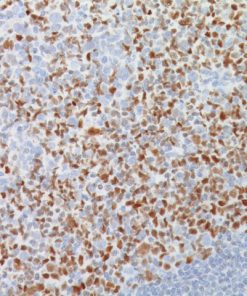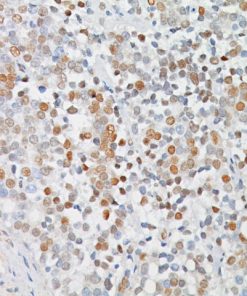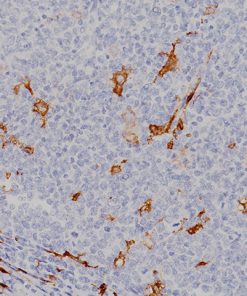Adipophilin
$266.00 – $530.00
Description
Product Description
Adipocyte differentiation-related protein (ADRP/ADFP) is associated with the globule surface membrane material. Adipophilin (also known as PLIN2) has been shown to detect the expression of ADFP in sebocytes and sebaceous lesions.15-18 Sebaceous carcinoma is a rare malignancy of the sebaceous glands which can mimic other malignant neoplasms (such as basal cell carcinoma, lymphoma, melanoma, Merkel cell carcinoma, and squamous cell carcinoma), as well as inflammatory processes (such as blepharitis and chalazion), resulting in delayed diagnosis, poorer prognosis, and suboptimal treatment.16 It has been reported that adipophilin has shown a specific pattern of membranous expression, staining 16 of 16 (100%) sebaceous adenomas and showing strong uptake at the periphery of intracytoplasmic lipid vacuoles. Of 25 sebaceous carcinomas, 23 (92%) were also labeled with a similar pattern.16 In cases of poorly differentiated sebaceous carcinoma, adipophilin staining of sebocytes and xanthelasmas was more reliable for interpretation of sebaceous differentiation than H&E sections.16 Metastatic renal cell carcinomas were also stained weakly to moderately positive for adipophilin.16 Adipophilin may be a useful marker in the identification of intracytoplasmic lipids, as seen in sebaceous lesions or in poorly differentiated sebaceous carcinomas, such as small periocular biopsy specimens.16,17 In addition, adipophilin has also been associated with lipid metabolism in Burkitt lymphoma and showed strong expression in the majority of Burkitt lymphomas.18 Adipophilin was also shown to be upregulated in lung adenocarcinoma and therefore may serve as a prospective marker for lung adenocarcinoma.19
Specifications
Specifications
| Intended Use | |
|---|---|
| Format | |
| Volume | |
| Source | |
| Clone | |
| Isotype | |
| Antigen | |
| Localization | |
| Positive Control |
Datasheets & SDS
| Download CE Marked IVD Datasheet |
| Download IVD Datasheet Without CE Mark |
| Download RUO Data Sheet |
| SDS Sheet |
Browse more documents for this product (IFUs, datasheets, translations, SDS, and more).
References
1. Heid HW, et al. Adipophilin is a specific marker of lipid accumulation in diverse cell types and diseases. Cell Tissue Res. 1998 Nov; 294(2):309-21.
2. Ostler DA, et al. Adipophilin expression in sebaceous tumors and other cutaneous lesions with clear cell histology: an immunohistochemical study of 117 cases. Mod Pathol. 2010 Apr; 23(4):567-73.
3. Milman T, Schear MJ, Eagle RC Jr. Diagnostic utility of adipophilin immunostain in periocular carcinomas. Ophthalmology. 2014 Apr; 121(4):964-71.
4. Ambrosio MR, et al. The alteration of lipid metabolism in Burkitt lymphoma identifies a novel marker: adipophilin. PLoS One. 2012; 7(8):e44315.
5. Zhang XD, et al. Identification of adipophilin as a potential diagnostic tumor marker for lung adenocarcinoma. Int J Clin Exp Med. 2014 Apr 15; 7(4):1190-6.
6. Center for Disease Control Manual. Guide: Safety Management, NO. CDC-22, Atlanta, GA. April 30, 1976 “Decontamination of Laboratory Sink Drains to Remove Azide Salts.”
7. Clinical and Laboratory Standards Institute (CLSI). Protection of Laboratory Workers from Occupationally Acquired Infections; Approved Guideline-Fourth Edition CLSI document M29-A4 Wayne, PA 2014.


